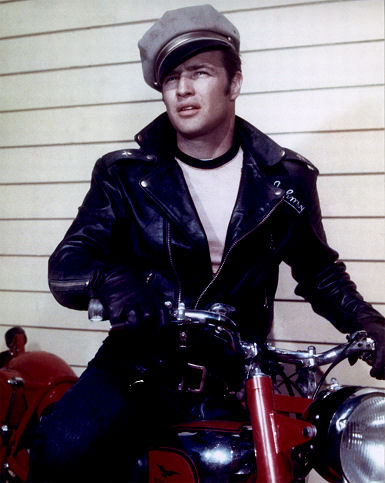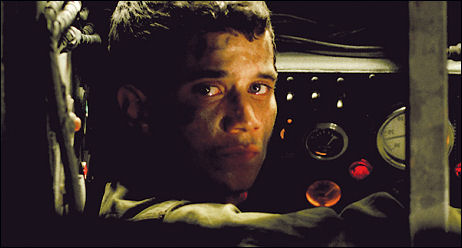Too many stars, Gary Marshall directing, Love Actually without Brits, out the window.
Day: September 20, 2009
Everything Fits
With almost any other screenwriter or screenwriters, this scene — this line, I mean — would just a good, vulgar, funny throwaway. But with the Coen brothers, it’s an integrated plot thread. Because Tara Reid‘s Bunny Lebowski really does need money, and to such a degree (we’ll eventually learn) that she’ll soon be a willing pawn in a fake kidnapping plot. This is what good screenwriting does. It decides that even a seemingly innocuous sex gag will feed into the whole.
Halfway Don’t Get It
“Movies that rise above, like A Single Man or Bright Star, will have a theatrical life for quite a while,” Apparition‘s Bob Berney tells Indiewire‘s Anne Thompson. “For financial reasons, not enough good films were for sale for buyers. A lot of films were misses. If a film is not really special, there is no in-between. It will not get a theatrical release. If it’s a halfway movie, audiences will skip it and watch it at home.”
You know what isn’t a halfway or an in-betweener? Chris Smith‘s Collapse. Where’s the disribution announcement on this one?
Producer Jonathan Dana provides the money quote in Thompson’s piece. “It’s a massacre…the end of funny money,” he says. He means funds “for anything above a micro-budget level that is too risky or daring or global,” Thompson explains, adding that “small-scale local productions will prevail, without counting on a North American theatrical release.”
I love the last part of the Dana paragraph in which Thompson summarizes his belief that “by dint of Darwinian forces of survival, movies will get better and stronger.” Oh, I see, I get it — filmmakers were holding back on their best efforts before? They were being…what, creatively whimsical as they psychologically cruised along on funny money, but now that it’s sink-or-swim, do-or-die season they’ll get real and try harder?
Not A Critic?
Awards Daily‘s Sasha Stone dislikes Indiewire‘s decision to refer to certain columnists (such as myself and Indiewire‘s Anne Thompson) as “critics” in their Toronto Critics Poll. “I’m not dissing these guys,” Stone writes, “[but] not just anyone can write about movies and be called a ‘critic.'”
I wouldn’t call myself a “critic” either. Certainly not in the Marshall Fine/Dana Stevens/Scott Foundas/Stephen J. Whitty sense of the term. Which can be otherwise defined as seeing every last film that comes along and sitting down like a rank-and-file machinist in Detroit and reviewing every last one (including and especially the awful-awfuls) and always with a five-or-six-paragraph plot synopsis. Which can otherwise be defined as being a good soldier who does the hard and once-necessary task of grappling with all of it, good or bad, rain or shine, sick or healthy. Critics do the job like those pilots in Howard Hawks‘ Only Angels Have Wings flew mail over the Andes.
But critics aren’t truly and finally critics unless they’re stone Catholics about movies, and I have always been that. I’ve been swimming in these waters for 30 years now and I don’t just skim across the surface of the pond when I see and write about a film. True Catholics put on the wetsuit and dive in each and every time. They swim to the bottom and search around and can identify and quantify the various fish and algae down there, not to mention the geological assessments of silt and sand and bedrock.
I do all that and then some. All my life I have felt and communed and wrestled with films as seriously and arduously as Martin Luther did with Catholicism before striking out with the Protestant Reformation. Okay, not every last flick made and distributed on the planet earth but most of the ones worth seeing. Yes, I’ve deliberately chosen not to suffer through each and every film that opens because 60% to 70% of them are soul-sucking torture to sit through, and some of the worst suffering I’ve endured in my life (which has included getting punched and spat upon, being in car and motorcycle accidents, getting arrested and put behind bars, being fired just before Christmas several times, getting divorced and seeing friends and family members die) has been due to bad films.
So I’m selective, yes, and my judgment is far perfect. But even in the murkiest waters I can spot and smell trouble from hundred of yards off, like a shark can pick up distress signals.
Stone is implying that blogger-columnists like myself just kind of bop-bop-bop along like red robins and throw out little zingers — i.e., less than fully considered reactions — after seeing this or that film. Sometimes I do toss out facile-seeming reactions but that’s because I’ve decided that a zinger is quite appropriate and sufficient. We all know what proper film criticism is and no, I don’t follow the form. But a fully considered response to a film doesn’t always have to be expressed in ten to twelve graphs with five or six devoted to some droning boilerplate synopsis.
What matters is whether or not you’re a life-long hairshirt Catholic and whether or not movies get to you in the same way that spiritual satori or lung cancer does. In this respect very few critics out there have anything on yours truly.
Who’s Joe?
Shine
Did David Poland tip off Informant! director Steven Soderbergh about his shooting angle idea for this interview, and did Soderbergh drive over to nearest shoeshine stand to spiff up before Poland arrived? Imagine how the piece would’ve played if Soderbergh was wearing beat-up Converses. Or, for that matter, canary yellow sneakers. Key quote: “I think we got the money for the Liberace film…so it’s gonna be next summer.”
Confederacy of Lefties
I was asking a few days ago why Oliver Stone‘s South of the Border, a reportedly flattering portrayal of Venezuela president Hugo Chavez that recently screened at the Venice Film Festival, wasn’t showing at Toronto. And then lo and behold I received an invite this morning to catch it on Wednesday evening (9.23) at the Walter Reade Theater. Stone will attend and do a q & a with Lincoln Center Film Society chief Richard Pena following the screening.
Bolivian president Evo Morales (interviewed in the doc) will also be there. It’s only a guess but it wouldn’t surprise if the Wall Street 2 team (including cast members Michael Douglas, Shia Lebeouf, Frank Langella, Carey Mulligan, etc.) would also attend in a show of support and solidarity for the boss.
“Whaddaya Got?”
I was momentarily seized this morning by a desire to see The Wild One in full balls-out Technicolor. What I mean is that I decided I’d break my vow of chastity and actually watch or even buy a colorized version. If, that is, someone were to colorize it in such a way that would make it truly Technicolorish, which has never been done and is probably impossible. I’m merely saying that in a blink of an eye I fell in love with that red motorcycle. I saw it and wanted more. These things happen from time to time.

Hebrew Hurt Locker?
I should have already linked to this 9.17 Steven Zeitchik/Risky Business piece about Samuel Maoz‘s Lebanon, a purportedly tense account of an Israeli tank crew fighting in the Israel-Lebanon war in 1982 (and, of course, another Toronto movie I didn’t manage to see).

“It’s inevitable, given both the gritty battlefield setting and the North American festival where it made its splash, that Lebanon would be compared to The Hurt Locker,” Zeitchick observed.
“There are a couple of important differences between Kathryn Bigelow‘s hair-raising look at American bomb-defusers in Iraq, which premiered at Toronto in ’08, and Maoz’s film. There’s more context and backstory for the soldiers in Locker than there is in the neo-verite, in-the-moment Lebanon, for instance.
“But the analogy is mostly on-point. Both pics are brutally effective at conveying some pretty tricky things: the abject fear soldiers feel; the terrible things they sometimes do; the examination of war in all its horror, both the tragedies and the banalities (Lebanon is especially good at the latter, giving a strong sense of the extreme physical and psychological discomfort of life inside an armored vehicle.)
“Waltz With Bashir has also been mentioned, and it’s not a bad reference point either. Both it and Lebanon are autobiographical accounts of the same war by former Israeli soldiers, though there’s none of the abstracting effect of animation here. It’s purely visceral filmmaking.
“Nearly the entire movie is set inside the tank (we see the outside world through the same lens that the gunman does). That may prompt some viewers to cry claustrophobia, but it’s also the movie’s great asset. Most big screen battle scenes give the viewer more information than any single soldier has access to. In Lebanon, however, we know only what they know and nothing more, which puts us right there with them. When they feel fear and isolation, we feel it too.
“There’s a scene in which the young crew gets stranded in enemy territory that’s reminiscent of The Blair Witch Project — they’re young, they realize they’re in way over their heads, there’s a great danger lurking out there that they can’t see but know is coming right for them — and in many ways is a lot more chilling. (No teary flashlight scenes, though.)”
Why Body Died
My spitball prediction for the weekend, had I given enough of a damn to make one last Wednesday or Thursday, never would have had Steven Soderbergh and Matt Damon‘s The Informant! beating Karyn Kusama, Diablo Cody and Megan Fox‘s Jennifer’s Body. And yet the former will probably come in third (right behind Tyler Perry‘s I Can Do Bad All My Myself) with something close to $10 million (okay, perhaps closer to $9 million) and Jennifer’s Body will end up with slightly less than $7 million. The latter was cheaply produced, but that doesn’t make it any less dead as we speak.
The conventional wisdom explanation for the failure of Body is that it wasn’t ferociously horrific enough to compete with previous genre standouts, and that women didn’t relate to/didn’t want to see the cruelly competitive relationship between Fox’s Jennifer and Amanda Seyfried‘s Needy, or they just don’t like Fox. (Who actually likes her? Big difference between that and being fantasized about.) In any case Cody is much lower on the totem pole this morning than she was a few days ago, Kusama is now a two-time loser in the all-female mass-market genre flick game (this and Aeon Flux) and Fox, dinged last week by an unflattering characterization on Michael Bay‘s website, has demonstrated she can’t (a) act or (b) open movies.
Credit should also go to Warner Bros. marketing for creating an inspired Informant! campaign that suggested a brisk comedic attitude and which actually bore similarities to the film itself….unusual!
